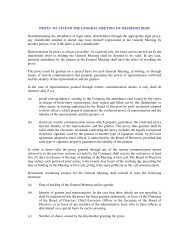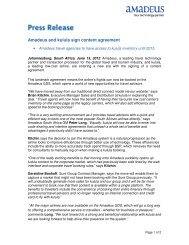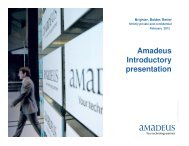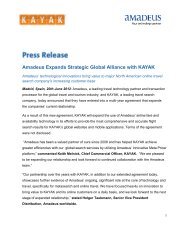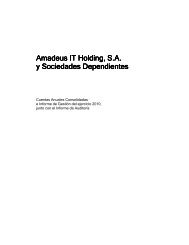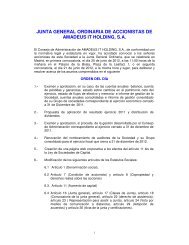Amadeus IT Holding, S.A. and Subsidiaries - Investor relations at ...
Amadeus IT Holding, S.A. and Subsidiaries - Investor relations at ...
Amadeus IT Holding, S.A. and Subsidiaries - Investor relations at ...
Create successful ePaper yourself
Turn your PDF publications into a flip-book with our unique Google optimized e-Paper software.
<strong>Amadeus</strong> ICFR model contains a Finance Risk & Control M<strong>at</strong>rix for the Group th<strong>at</strong> includes<br />
eight main business cycles considered relevant in the Financial St<strong>at</strong>ements elabor<strong>at</strong>ion:<br />
• Sales- Revenue<br />
• Purchasing<br />
• Fixed Assets<br />
• Human Resources Management<br />
• Treasury<br />
• Tax Management<br />
• Closing <strong>and</strong> Reporting<br />
• Consolid<strong>at</strong>ion<br />
The eight business cycles include 42 processes <strong>and</strong> 83 sub processes. A total of 248 controls<br />
have been defined, in order to achieve the objectives rel<strong>at</strong>ed to reliability <strong>and</strong> integrity of<br />
financial inform<strong>at</strong>ion so as to prevent, detect, mitig<strong>at</strong>e, compens<strong>at</strong>e or correct their potential<br />
impact.<br />
<strong>Amadeus</strong> has determined the ICFR entities scope on the Group main sites: <strong>Amadeus</strong> <strong>IT</strong><br />
<strong>Holding</strong>, S.A.; <strong>Amadeus</strong> <strong>IT</strong> Group, S.A.; <strong>Amadeus</strong> Capital Markets, S.A.U.; <strong>Amadeus</strong> s.a.s.<br />
<strong>and</strong> <strong>Amadeus</strong> D<strong>at</strong>a Processing GmbH. These ICFR entities scope represent 93% of the<br />
revenues, 84% of the assets <strong>and</strong> 68% of the equity of the consolid<strong>at</strong>ed inform<strong>at</strong>ion.<br />
<strong>Amadeus</strong> considers as corpor<strong>at</strong>e four of the business cycles: Sales-Revenue, Treasury, Tax<br />
Management, <strong>and</strong> Consolid<strong>at</strong>ion, as these cycles are mainly rel<strong>at</strong>ed <strong>and</strong> managed <strong>at</strong><br />
corpor<strong>at</strong>e level. The other cycles (Purchasing, Fixed Assets, Human Resources Management<br />
<strong>and</strong> Closing <strong>and</strong> Reporting) are common to all Group companies.<br />
The structure of the Financial Risk M<strong>at</strong>rix includes the following inform<strong>at</strong>ion:<br />
• Control objective, as the requirements to be fulfilled for each process cycle, in line<br />
with the definition of the internal control. They assess the accuracy of financial<br />
inform<strong>at</strong>ion covering the assertions of existence <strong>and</strong> occurrence, completeness,<br />
valu<strong>at</strong>ion, rights <strong>and</strong> oblig<strong>at</strong>ions <strong>and</strong> present<strong>at</strong>ion <strong>and</strong> disclosure.<br />
• Risks, as the possible event or action th<strong>at</strong> may impact the business capacity to<br />
meet the financial reporting objectives <strong>and</strong>/or successfully implement str<strong>at</strong>egies.<br />
• Control description, as the defined control activities inserted into policies,<br />
procedures <strong>and</strong> practices applied by the Company in order to ensure th<strong>at</strong> control<br />
objectives are met <strong>and</strong> the risk is mitig<strong>at</strong>ed.<br />
• Evidence, as the document<strong>at</strong>ion kept by the control owner (company personnel),<br />
so all the model can be monitored <strong>and</strong> audited on a periodical basis.<br />
A first level of classific<strong>at</strong>ion indic<strong>at</strong>es if the control is key <strong>and</strong>/or fraud rel<strong>at</strong>ed. The controls<br />
have been defined as preventive or detective, <strong>and</strong> manual, semi-autom<strong>at</strong>ed or autom<strong>at</strong>ed, in<br />
terms on how their monitoring can be performed using d<strong>at</strong>a extracted from autom<strong>at</strong>ic tools.<br />
Control owners have been defined for each control activity. All evidences have been obtained<br />
from control owners <strong>and</strong> presented <strong>and</strong> agreed with the functional process owners, <strong>and</strong> have<br />
been autom<strong>at</strong>ed, when possible.<br />
The Internal Control Unit ensures th<strong>at</strong> all controls are implemented by the process owners,<br />
<strong>and</strong> they monitor the control evidences on a regular basis. Group Internal Audit Office<br />
performs the regular audit of the controls <strong>and</strong> valid<strong>at</strong>es if the controls oper<strong>at</strong>es effectively as<br />
intended <strong>and</strong> effectively designed.<br />
Entity Level Controls are the principals in which the internal control is based, <strong>and</strong> cover the<br />
following issues:<br />
• Integrity <strong>and</strong> ethical values.<br />
• Commitment to professional competence.<br />
• Management philosophy <strong>and</strong> style.<br />
• Organis<strong>at</strong>ional structure.<br />
• Deleg<strong>at</strong>ion of authority <strong>and</strong> responsibility.<br />
• Human resources policies <strong>and</strong> practices.<br />
The Group has established a framework on good practices to ensure the reliability of the<br />
regul<strong>at</strong>ed financial inform<strong>at</strong>ion, including the monitoring of the internal control system by<br />
management.<br />
8





